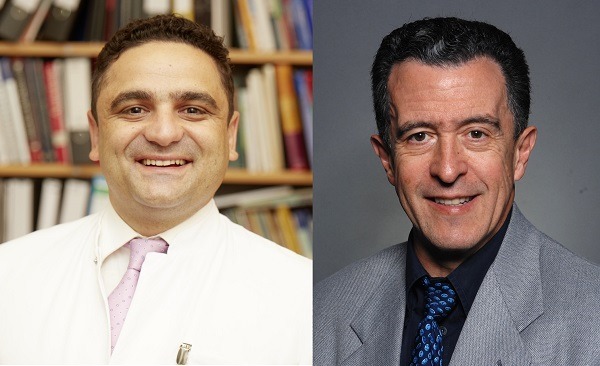
In a 15-year evolution, parallel graft techniques have emerged as part of the effort to rescue or preserve excluded aortic branches in the context of endograft repair of complex aortic disease. While rescue was most often central to such procedures in the early days, planned vessel-branch revascularisation is more frequently cited today as the main reason for their use, write Frank J Criado and Konstantinos P Donas.
It is interesting that developments with branched and fenestrated endografts have unfolded during the same timeframe as chimney techniques; their worth and clinical importance are beyond question. However, so far they have failed to become totally ubiquitous because of persistent issues related to availability, sizing and procedural complexity, and cost. Unlike parallel grafts, fenestrated repair tends to be highly resource-intensive.
Multiple names have been given to these techniques, including chimneys, snorkels, CHIMPS, periscopes, and sandwich grafts, among others. But we feel—together with many others—that “parallel grafts” should be considered as the all-encompassing term that best captures the one feature all branch-preserving conduits share—their intra-aortic parallel course, external to but alongside, the main aortic endograft. That is the concept; they need not be geometrically parallel to be deserving of the label. The conduit (stent or stent graft) forms a flow channel that runs between the stent graft and the aortic wall, preserving or restoring branch-vessel blood flow.
Conceptually, it could be said the chimney graft internalises the branch vessel origin within the aortic lumen, lending support to the term “endo-branching” that has also been used to describe the technique.
Roy Greenberg was first to use a chimney stent to revascularise the unintentionally covered right renal artery in 2001 during a complex endovascular aneurysm repair (EVAR) procedure (Table 1). Interestingly, the term “snorkel” was actually suggested before “chimney” by Robert Rutherford, then editor of the Journal of Vascular Surgery, during his pre-publication review of the manuscript by Greenberg et al.
In April 2003, Criado placed a bare metal stent in the left common carotid artery (via retrograde percutaneous puncture in the left side of the neck) to re-establish antegrade flow after unintentional stent-graft coverage during a TEVAR procedure for treatment of arch aneurysm. It was a rescue chimney stent. Larzon et al performed an almost identical procedure in 2004 to lengthen the proximal fixation zone during TEVAR, but this was done semi-electively and as a component of the procedural plan.
In a 2007 letter to the JEVT editors, Criado documented and illustrated the concept of using longer chimney conduits for arch and abdominal aortic repair. It was to become one of the foundations for subsequent developments and new ideas, including the Lachat-Mayer “periscope” technique first performed by the Zurich group in 2008 to revascularise (from a trans-femoral access) the visceral arteries during stent-graft repair of a ruptured thoracoabdominal aortic aneurysms. Lobato’s sandwich graft procedures followed, first performed in 2008 for revascularisation of the hypogastric artery during abdominal aortic aneurysm repair,7 and in 2009 for the visceral and renal arteries in the context of thoracoabdominal aortic aneurysm treatment.
In 2010, Donas et al published the first significant clinical series (with more than 10 patients) of patients with juxtarenal aortic aneurysms whose treatment was facilitated by placement of a single chimney graft in the renal artery. In the same year, Kasirajan et al proposed a creative new approach (for treatment of thoracoabdominal aortic aneurysms) consisting of the use of two inverted abdominal bifurcated stent grafts in the descending thoracic aorta with subsequent antegrade deployment of additional multiple long conduits extending from the iliac limbs into the visceral arteries. A technical modification of this idea proposed by Silveira Galvagni in 2011 obviated the need to use two abdominal grafts.
One year later Mestres et al published the first in vitro comparison of several chEVAR device combinations. They found that gutter formation could be minimised by oversizing the aortic stent graft by 30% using a combination of Endurant (Medtronic) and Advanta V12 (Maquet) balloon-expandable covered stent, or Excluder with the Viabahn (Gore) self-expanding covered stent. These findings were re-affirmed the same year in a clinical report of the large experience of two high-volume centres. Münster and Zurich also reported shortly thereafter on the first computed tomography (CT) angiography-based evaluation of aneurysm sac changes (during the two-year follow-up) in 40 patients. That same year, Lachat et al published the first instance of transfemoral placement of parallel grafts in the renal arteries, also known as the “lift technique”.
Current status
Until recently, parallel graft techniques lacked a solid evidence foundation as available clinical data and publications were clearly insufficient to validate their growing use. In the last few years, however, several significant review articles have provided a far more compelling picture. But the greatest impetus has come from the international PERICLES Registry in 2015 in an effort launched at the prompting of the leadership of Frank Veith, Konstantinos Donas and Jason T Lee. They laid the foundation for collecting the experience of leading chimney graft centres in Europe (n=9) and the USA (n=4). As anticipated, chEVAR (for treatment of complex-anatomy abdominal aortic aneurysm) emerged as the most frequent parallel graft procedure. The results surpassed everyone’s expectations as the relatively low rate of reinterventions for related endoleaks and patency of the chimney grafts proved very satisfactory overall.
In 2016, Donas et al published the PROTAGORAS study evaluating the performance of the Endurant abdominal device with balloon-expandable covered chimney stents in 128 patients with complex aortic disease. The results were promising as they underscored the importance of standardisation of technique and device choices.
Moreover, in early 2017, the PERICLES Registry collaborators illustrated and proposed a novel classification (based on the causative mechanisms) of type Ia endoleaks and persistent gutters following chEVAR aortic repair. It is hoped this will serve as a springboard to further establish the important underlying principles to optimise results in the first place, and the development of treatment algorithms for management once such complications have occurred. As is widely agreed upon, these gutters and related endoleaks represent indeed the Achilles’ heel of the chEVAR procedure. Finally, the CE mark granted to chEVAR Endurant with balloon-expandable chimney covered stents in 2016 has elevated their status to one of approved on-label therapy in specific anatomical conditions.
| Table 1: Historical milestones for parallel grafts | ||
| 2001 | Greenberg et al | First chimney (renal artery) |
| 2003 | Criado et al | First arch branch chimney (left carotid artery) |
| 2004 | Larzon et al | First planned arch branch chimney (left carotid artery) |
| 2007 | Criado et al | Suggested/illustrated use of longer chimneys |
| 2008 | Malina et al | Popularisation of the term “chimneys” |
| 2008 | Lachat-Mayer et al | Periscope graft (visceral/renal arteries) |
| 2008 | Lobato et al | Sandwich graft procedure (hypogastric artery) |
| 2009 | Lobato et al | Sandwich graft procedure (visceral arteries) |
| 2010 | Kasirajan et al | Two inverted bifurcated abdominal stent grafts plus multiple thoracoabdominal long conduits coming antegrade from the iliac limbs |
| 2010 | Donas et al | Report of first clinical series (>10 patients) in treatment of juxtarenal aneurysms |
| 2012 | Mestres et al | In vitro testing of best device combinations for chEVAR |
| 2013 | Donas et al | Publication of clinical results confirming Mestres et al findings |
| 2015 | Donas, Lee et al | Worldwide collected experience (PERICLES Registry) results published |
| 2016 | Donas, Torsello et al | PROTAGORAS Study as the first attempt to standardise the chimney technique |
| 2017 | Donas, Criado et al | Novel classification (based on the causative mechanisms) of type Ia endoleaks and persistent gutters following chEVAR aortic repair |
Technical evolutions
Early applications involved use of short chimney stents, both in the arch and the pararenal abdominal aorta, with recognition that balloon-expandable devices perform better because of their superior radial strength. The latter has been found to be particularly important for use in the left subclavian artery during zone 2 TEVAR. But transition into longer self-expanding covered stents came shortly thereafter, with an early comparison of the two techniques published in 2012.
Today the most common uses involve short or relatively short balloon-expandable covered stents in the juxta- and pararenal aorta, and long or relatively long conduits made of self-expanding covered stents for thoracoabdominal aortic aneurysm treatment and in the aortic arch. The Advanta V12 and similar devices are favoured for the former, whereas the Viabahn stent graft is the clear favourite for the latter.
Conclusions
Parallel graft techniques have evolved to become important versatile endovascular solutions in the setting of endograft repair for complex aortic disease. One could almost say they are now documented to perform better than they “should”. Nonetheless, their utility cannot be denied, and clinical application continues to grow. The relatively recent addition of a far more robust evidence basis has gone a long way to enhancing their validity and to justify the important place they occupy in the armamentarium of the endovascular aortic surgeon. Continued unqualified scepticism regarding their use can no longer be justified, especially in the setting of juxtarenal aneurysms with involvement of one or at most two aortic branches and when fenestrated repair is deemed impractical or unfeasible. In the end, it must be emphasised that much work remains to be done in the pursuit of optimal parallel graft results, with emphasis on determining best device combinations for the various aortic segments.
Frank J Criado is at MedStar Union Memorial Hospital, Baltimore, USA. Konstantinos P Donas is at St Franziskus Hospital, Münster, Germany
References
- Greenberg RK, Clair D, Srivastava S, et al. J Vasc Surg 2003; 38: 990–6.
- Greenberg RK. Personal communication (to Criado FJ), June 2010.
- Criado FJ. J Endovasc Ther 2007; 14: 54–58.
- Larzon T, Gruber G, Friber O, et al. Eur J Vasc Endovasc Surg 2005; 30: 147–51.
- Criado FJ. J Endovasc Ther 2007; 14: 823–4.
- Lachat M, Frauenfelder T, Mayer D, et al. J Endovasc Ther 2010; 17: 216–20.
- Lobato AC. J Endovasc Ther 2011; 18: 106–11.
- Lobato AC, Camacho-Lobato L. J Endovasc Ther 2012; 19: 691–706.
- Donas KP, Torsello G, Austermann M, et al. J Endovasc Ther 2010; 17(5): 589–93.
- Kasirajan K. J Endovasc Ther 2011; 18: 471–6.
- Silveira PG, Galego GN, Bortoluzzi CT, et al. J Endovasc Ther 2012; 19: 130.
- Mestres G, Uribe JP, Garcia-Madrid C, et al. Eur J Vasc Endovasc Surg 2012; 44(5): 468–73.
- Donas KP, Pecoraro F, Torsello G, et al. J Vasc Surg 2012 Mar; 55(3): 659–65.
- Donas KP, Pecoraro F, Bisdas T, et al. J Endovasc Ther 2013; 20(1): 1–6.
- Lachat M, Bisdas T, Rancic Z, et al. J Endovas Surg 2013; 20(4): 492–7.
- Donas KP, Lee JT, Lachat M, et al. Ann Surg 2015; 262: 546–53.
- Donas KP, Torsello GB, Piccoli G, et al. J Vasc Surg 2016; 63(1): 1–7.
- Donas KP, Criado FJ, Torsello G, et al. J Endovasc Ther 2016; DOI:wv10.1177/1526602816678994













